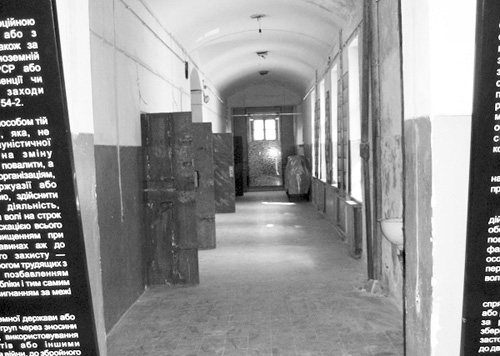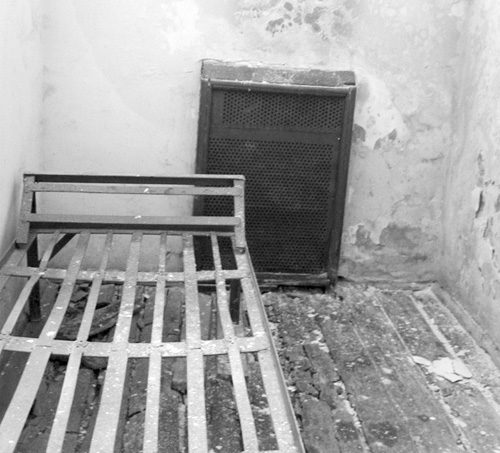
By
Natalia A. Feduschak, Kyiv Post,
May 11, 2010
LVIV, 
An acquaintance who lived
across the street from the penitentiary told them that on the night of
What Kindrat saw at the
prison, which was run by the NKVD, the Soviet secret police, horrified
him.
“From the courtyard, doors
led to a large space, filled from top to bottom with corpses,” he later wrote.
“The bottom ones were still warm. The victims were between 15 and 60 years old,
but most were 20-35 years old. They laid in various poses, with open eyes and
masks of terror on their faces. Among them were many women. On the left wall,
three men were crucified, barely covered by clothing from their shoulders, with
severed male organs. Underneath them on the floor in half-sitting, leaning
positions – two nuns with those organs in their mouths. The victims of the NKVD’s
sadism were killed with a shot in the mouth or the back of the head. But most
were stabbed in the stomach with a bayonet. Some were naked or almost naked,
others in decent street clothes. One man was in a tie, mostly likely just
arrested.”
Within a week, photographs
that Kindrat took at the prison were published in Krakivsky Visti, a
Ukrainian-language newspaper based in
 As Ukraine, Russia and
Belarus elaborately commemorated the 65-year anniversary of the Soviet Union’s
victory over Nazi Germany on May 9, Lviv’s Prison on Lonckoho Museum stands as
a stark reminder of the other side of history – the terrors Soviet authorities
unleashed on their own people, both during and after World War II.
As Ukraine, Russia and
Belarus elaborately commemorated the 65-year anniversary of the Soviet Union’s
victory over Nazi Germany on May 9, Lviv’s Prison on Lonckoho Museum stands as
a stark reminder of the other side of history – the terrors Soviet authorities
unleashed on their own people, both during and after World War II.
Soviet archival documents
discovered later revealed that of the prison’s 3,638 detainees, 1,366 were
executed from
“The museum is meant to
preserve the national memory,” said Iryna Yezerska, a young researcher who is
focusing on the prison’s history. “It is a reminder that these crimes against
people shouldn’t happen again.”
Located near Lviv’s famed
Polytechnic Institute near the city centre, the Prison on
One of the museum’s guiding
principles is to show visitors the conditions in which detainees lived and to
indicate those places where mass executions took place, said museum director
Ruslan Zabiliy.
“We wanted to preserve what
was here,” Zabiliy said.
To that end, the museum is
an object frozen in time. With peeling paint and rust on the walls, the
building looks just as it did when the secret police vacated the building in
the early years of
Off its long corridors are
cells once meant for those condemned to death: The windows are boarded up so
that sunlight, which could indicate the time of day, cannot filter in. Museum
staff members have recreated rooms where detainees were questioned and in one
cell painted a white square on the floor that shows how much space was
allocated to each prisoner – half a square metre. Although cells were supposed
to hold six people, they often held 10-15 people for days and months on end.
The room where inmates had their pictures taken remains intact.
Rooms also commemorate those
bloody days in June 1941, when the Soviet secret police began massacring
Ukrainians. Pasted on the walls in one room are clippings from Ukrainskiy
Schodenniy Visti (Ukrainian Daily News), which ran ads by relatives
looking for family members who were detained by the NKVD. Another wall
denotes the number of people who were killed in the prison from nearby
villages.
Black-and-white footage of
desecrated bodies lying in the prison’s courtyard and weeping relatives bent
over in anguish replays in another room. Upon reaching the prison, the Germans
had immediately filmed the results of the Soviet massacre and used it for
propaganda purposes. The film was shown internationally. Soon, foreign media
from then-neutral countries, as well as the International Red Cross, descended
on Lviv to document the horrors.
It was not long, though,
before the Germans began their own executions at the prison.
First on their list were
members of the more radical Bandera faction of the Organization of Ukrainian
Nationalists, often referred to as Banderites. Established in 1929, OUN strove to
create an independent and unified Ukrainian state, frequently using armed
struggle to achieve its goals. The
After the Soviet Union
consolidated its power over Western Ukraine in 1944, the prison continued to be
Lviv’s primary holding centre for Ukrainian nationalists who were frequently
detained, questioned – and sometimes shot – before being shipped off to
Siberian labour camps. In the sixties and seventies, the prison housed some of
Despite its long and mostly
tragic history, the prison museum today faces an uncertain future.
The museum was supposed to
become a part of the Ukrainian Institute for National Memory until
Although one of the benefits
in being a national museum is that it is funded through the state budget, the
government of Prime Minister Mykola Azarov has not allocated any money for the
museum this year, including employee salaries, said Zabiliy. Some in Lviv say
because of its significance, authorities in Kyiv are afraid to shut the museum
down, but hope it will die its own death through a lack of funding.
Zabiliy said he is certain
the museum will survive, although as a result of the financial cut-off, many of
the plans for expansion are now on hold. Staff had hoped to create a museum
using the latest media technologies that would give the visitor a better feel
for the complex history which led to the atrocities that took place there, as
well as create conditions for scholars to conduct research.
Currently, the museum is
functioning largely through donations from local philanthropists who believe in
the museum’s importance, said Zabiliy.
“People are not apathetic,”
he said.
About the museum:
The Prison on
PHOTOS
2 - The typical size of a
prison cell that at one time held up to 15 people